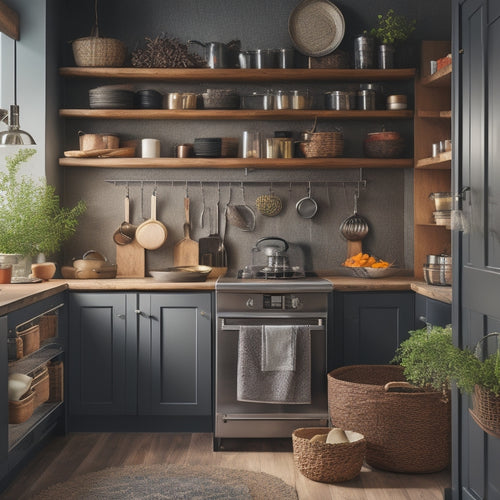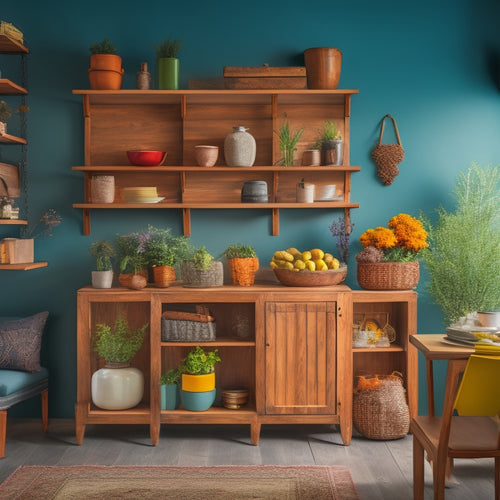
3 Essential Tips for Efficient Cabinet Organization
Share
To achieve efficient cabinet organization, you'll need to assess your space needs, optimize your layout, and implement effective storage solutions. Start by monitoring what you store, determining how often you access items, and measuring your cabinet dimensions. Next, divide your cabinets into zones, prioritize frequently used items, and utilize vertical storage. Finally, focus on decluttering, grouping similar items together, and establishing a clear labeling system. By following these three essential tips, you'll be well on your way to a clutter-free cabinet - and there's even more you can do to maximize your space.
Key Takeaways
• Monitor cabinet usage to determine storage requirements and prioritize items based on frequency of use.
• Allocate space efficiently by identifying zones for different item types and utilizing vertical storage solutions.
• Declutter cabinets, group similar items together, and establish a clear labeling system for efficient item identification.
• Maximize storage capacity by optimizing cabinet layout and design, avoiding overcrowding, and focusing on decluttering.
• Implement a labeling system that saves time and reduces frustration, using easy-to-read labels with pictures or icons.
Assessing Your Cabinet Space Needs
Evaluating Your Cabinet Space Requirements
Ascertain how you utilize your cabinets by monitoring what you store in them and how frequently you access each item. This will aid you in pinpointing your specific storage requirements.
Make a note of the items you use daily, weekly, and occasionally. This will provide you with a clear understanding of what you need to prioritize when arranging your cabinets.
Subsequently, measure the space you have at your disposal. Take accurate measurements of the interior and exterior of your cabinets, including the height, width, and depth.
Remember to consider any hindrances, such as plumbing or electrical fixtures. This will assist you in determining the maximum size of the items you can store and the most effective way to organize them.
Optimizing Cabinet Layout and Design
Now that you've evaluated your cabinet space requirements, you can begin designing a layout that maximizes storage and accessibility.
To optimize your cabinet layout and design, consider the following essential tips:
-
Identify zones: Divide your cabinet into zones based on the type of items you'll store, such as baking supplies, cooking utensils, or cleaning products. This will help you allocate space efficiently.
-
Prioritize frequently used items: Place frequently used items in easy-to-reach locations, while less frequently used items can be stored in harder-to-reach areas.
-
Consider vertical storage: Make the most of your cabinet's vertical space by using stackable shelves, baskets, or bins to store items like plates, cups, or cleaning supplies.
- Leave space for growth: Don't overcrowd your cabinet. Leave some space for future additions or changes in your storage needs.
Implementing Storage Solutions Effectively
With your optimized cabinet layout and design in place, you're ready to implement storage solutions that will keep your cabinets organized and clutter-free. To maximize space utilization, focus on decluttering techniques that eliminate unnecessary items and group similar items together. This will help you create a sense of order and make the most of your available space.
Next, establish a labeling system that clearly identifies what's stored in each cabinet or container. This will save you time and frustration when searching for specific items. Use labels that are easy to read and understand, and consider adding a picture or icon to help distinguish between similar items.
Frequently Asked Questions
How Often Should I Clean and Maintain My Cabinet Organization System?
'You're not alone if you think cleaning your cabinet organization system is a challenging task, but trust us, it's worth it! Aim to clean and maintain it every 2-3 months to guarantee efficiency and save time in the long run.'
Can I Customize Cabinet Organization for My Specific Needs and Habits?
You can definitely customize cabinet organization to fit your individual habits and specialized needs. By creating personalized solutions with customized layouts, you'll maximize storage and efficiency, making your life easier and more organized.
Are There Any Eco-Friendly Cabinet Organization Materials and Options?
You're looking for eco-friendly cabinet organization materials and options! You'll find sustainable solutions like recycled plastic bins, bamboo shelves, and natural fiber baskets that support your green lifestyle and promote eco-friendly organization in your space.
How Do I Prevent Clutter From Building up Again After Organization?
You'll prevent clutter from building up again by developing consistent organization habits, like scheduling regular decluttering sessions, and implementing maintenance techniques, such as the "one in, one out" rule, to keep your space tidy and organized.
Can I DIY Cabinet Organization or Should I Hire a Professional?
"Will you really save time and money by DIYing cabinet organization, or will it end up a costly hassle? Consider your skills, time, and budget: if it's a complex task, hiring a pro might be worth the investment for a stress-free, customized solution."
Related Posts
-

Over-The-Door Kitchen Storage for Apartment Living
Over-the-door kitchen storage is a smart solution for apartment living, allowing you to maximize vertical space while...
-

Creative Organization Ideas for Tight Kitchen Spaces
To create an organized kitchen in tight spaces, think upwards. Install shelves that reach the ceiling and use wall-mo...
-

Creative Corner Cabinet Space Management
Creative corner cabinet space management turns neglected nooks into stunning storage solutions. You can maximize vert...


